Birthstones: A Complete Guide to Their History, Meaning, and Beauty
There’s something deeply personal about wearing a gemstone associated with your birth month. Birthstones carry centuries of tradition, symbolism, and beauty, making them more than just stunning jewellery pieces—they’re wearable connections to our personal stories. At Joseph George Jewellery, we understand the significance of these gems for our clients. We approach each birthstone creation with meticulous attention to detail and respect for both traditional meanings and modern interpretations.
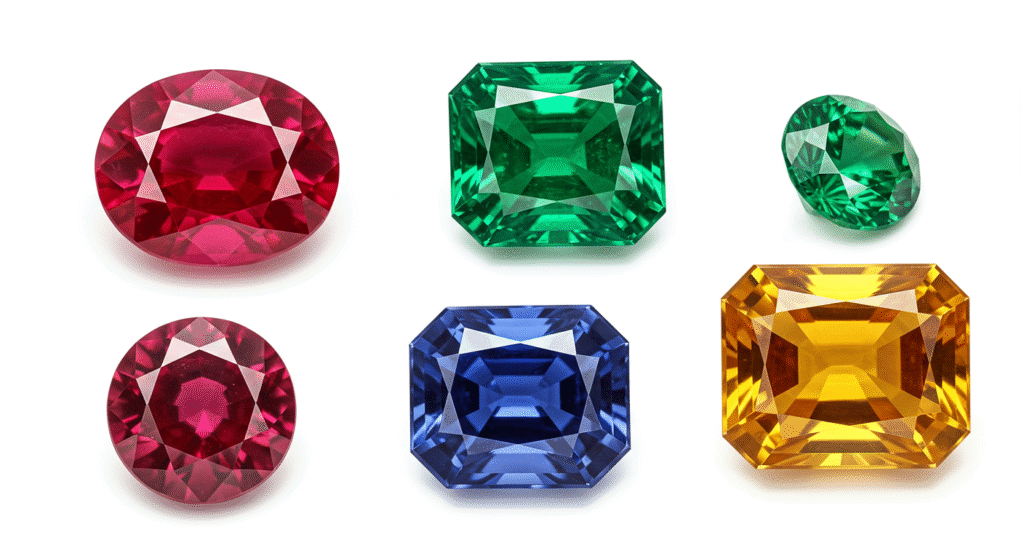
The Rich History of Birthstones
Ancient Origins
The concept of birthstones dates back thousands of years. Some historians trace their origins to the ancient civilisations of Babylon and India, where astrologers assigned specific gemstones each month based on their perceived cosmic properties. These early connections between gems and celestial bodies established the foundation for what would eventually become our modern birthstone tradition.
Biblical Connections
Perhaps the most famous historical reference to birthstones appears in the Book of Exodus, which describes the Breastplate of Aaron. This ceremonial religious garment featured twelve precious gemstones, each representing one of the twelve tribes of Israel. While these weren’t explicitly connected to birth months originally, this biblical foundation later influenced Western birthstone traditions as Christianity spread throughout Europe.
Evolution Through Cultures
The specific assignment of gemstones to birth months evolved significantly over time. Polish jewellers in the 15th century began marketing birthstones more formally. Still, standardisation didn’t take hold until 1912, when the American National Association of Jewellers (now Jewellers of America) established the first official birthstone list. This list has undergone several revisions over the decades, most recently in 2016 with the addition of spinel as an August birthstone.
Complete Birthstone Guide by Month
January to March Birthstones
January: Garnet. Far more than just a deep red gem, garnets come in a rainbow of colours, including vibrant greens, oranges, and purples. The name derives from the Latin “granatus,” meaning “seedlike,” as the stones resembled pomegranate seeds. Symbolising friendship and trust, garnets were exchanged as gifts between friends in ancient Rome to ensure they would meet again.
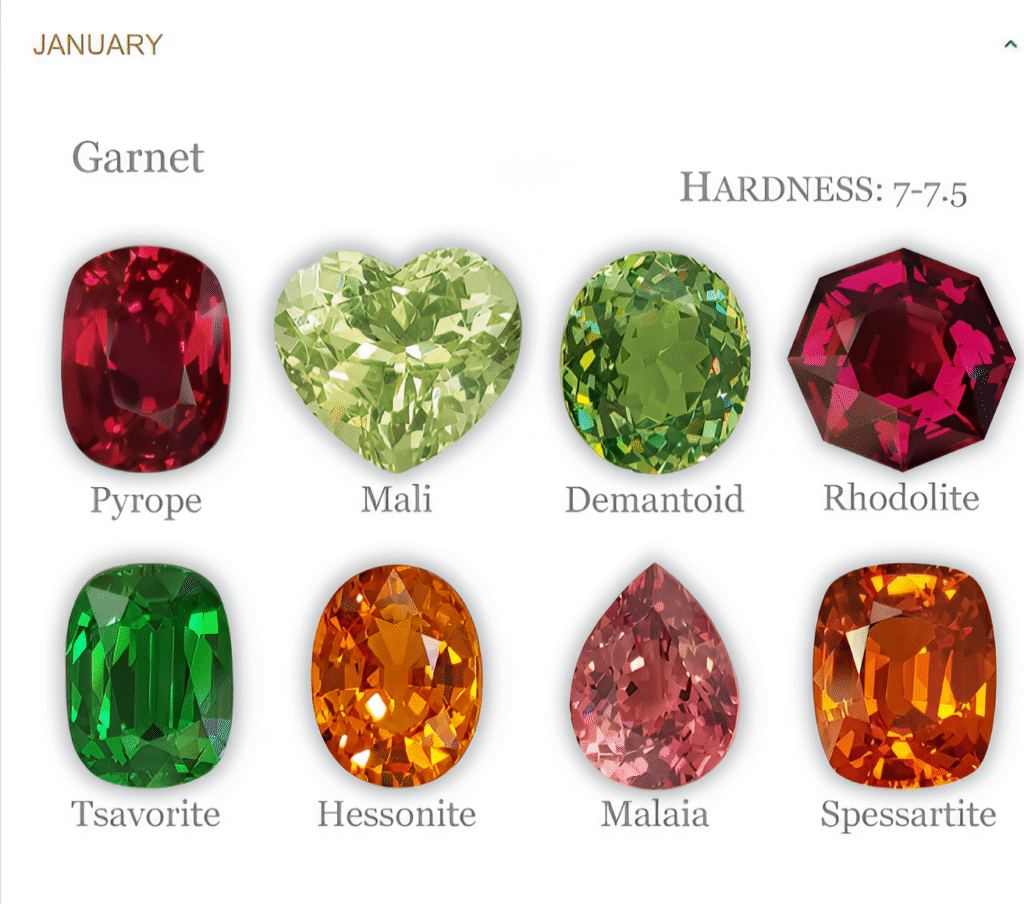
February: Amethyst. Once considered more valuable than diamonds, this purple variety of quartz ranges from pale lilac to deep purple. For centuries, amethyst was considered protection against intoxication—the name comes from the Greek “amethystos,” meaning “not intoxicated.” Today, it represents clarity of thought, sincerity, and peace.
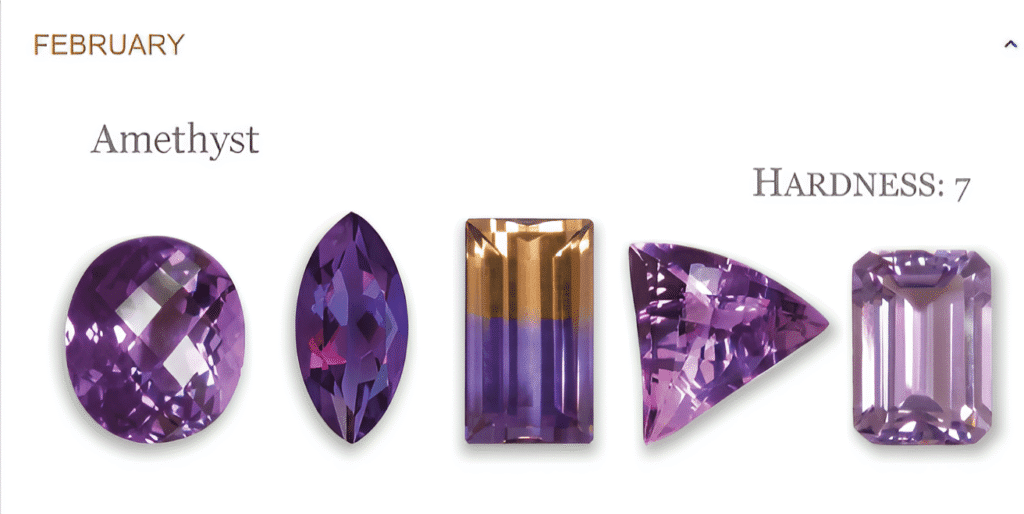
March: Aquamarine and Bloodstone. Aquamarine’s name perfectly captures its serene blue colour that evokes the sea. Ancient mariners carried this gem as protection during voyages across treacherous waters. Its clarity and light blue hues make it versatile for various jewellery styles.
Bloodstone, March’s traditional birthstone, is a dark green jasper flecked with red spots of iron oxide. These red inclusions were said to represent Christ’s blood, making bloodstone a deeply symbolic stone in Christian traditions.

April to June Birthstones
April: Diamond. The ultimate symbol of enduring love, diamonds have adorned engagement rings since 1477 when Archduke Maximilian of Austria commissioned the first diamond engagement ring for Mary of Burgundy. As the hardest natural substance on earth (rating 10 on the Mohs scale), diamonds are forever. Beyond their remarkable durability, diamonds represent clarity, purity, and invincible strength.

May: Emerald Treasured for over 4,000 years, emeralds were Cleopatra’s gemstone of choice and remain among the most prized colored gemstones. These verdant green beryl crystals are typically more valuable than diamonds of equal weight. The finest emeralds come from Colombia, though significant deposits exist in Brazil, Zambia, and Zimbabwe. Symbolising rebirth and love, emeralds were believed to grant the wearer foresight and protection against evil spells.

June: Pearl, Alexandrite, and Moonstone. June offers three distinct options. Uniquely, as the only birthstone created by living creatures, pearls symbolise purity and have adorned royalty for centuries. Alexandrite, discovered in the 1830s in Russia, displays remarkable colour-changing properties from green in daylight to red in incandescent light. Moonstone, with its ethereal blue sheen, appears to glow from within and represents new beginnings.

July to September Birthstones
July: Ruby. The fiery ruby has been valued since ancient times for its intense red colour, which was believed to represent the life force or blood. Symbolising passion and protection, rubies were worn by warriors entering battle in various cultures. Only diamonds surpass rubies in hardness, making them durable for everyday wear.

August: Peridot and Spinel. Peridot is one of the few gemstones that occurs in only one colour—an olive-green that varies in intensity. Ancient Egyptians called it “the gem of the sun.” Spinel, added officially in 2016, comes in various colours, including intense reds often mistaken for rubies throughout history.
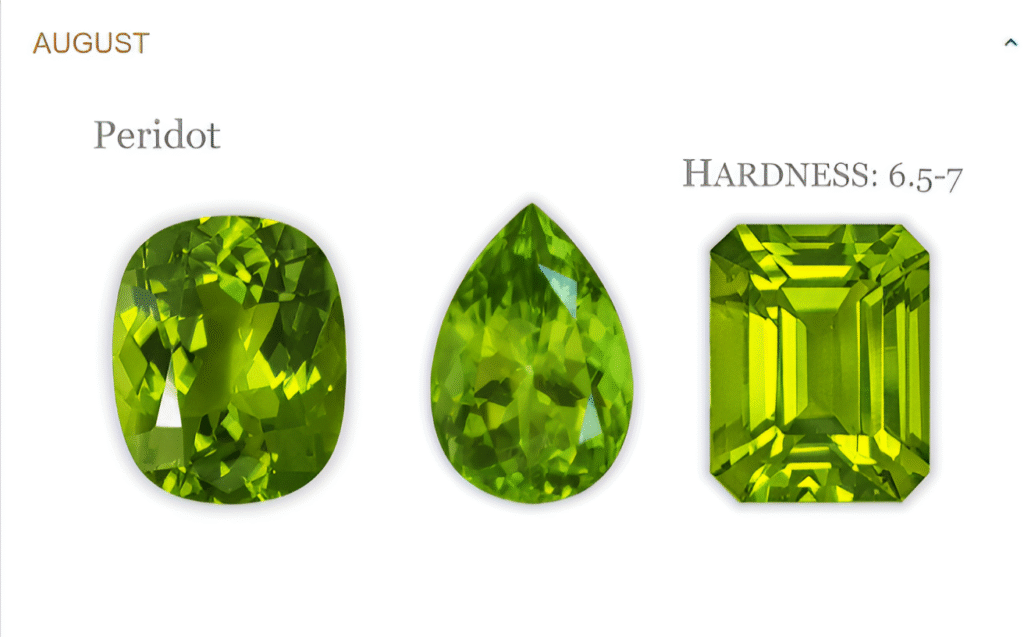
September: Sapphire Though most are associated with blue, sapphires come in every colour except red (which would classify them as rubies). These corundum gems symbolise loyalty and wisdom. Historically, clergy wore sapphires to symbolise heaven, while royalty wore them to protect themselves from envy and harm.
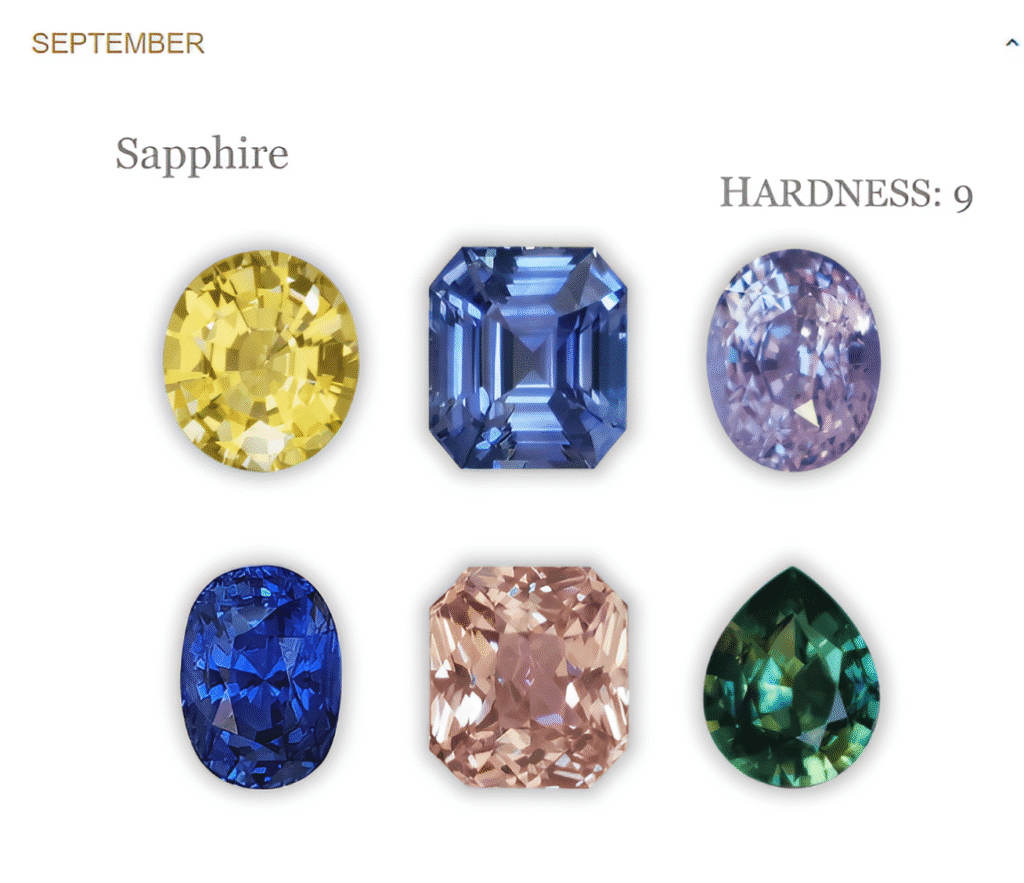
October to December Birthstones
October: Opal and Tourmaline. The play of colours in precious opals has inspired awe for centuries. No two opals are alike, making each piece truly unique. Tourmaline offers the widest colour range of any gemstone, sometimes displaying multiple colours in a single crystal.

November: Topaz and Citrine Imperial topaz in golden-orange hues was reserved for Russian royalty, while citrine’s warm yellow tones evoke prosperity and abundance. Both stones brighten the often grey November days with their sunny dispositions.
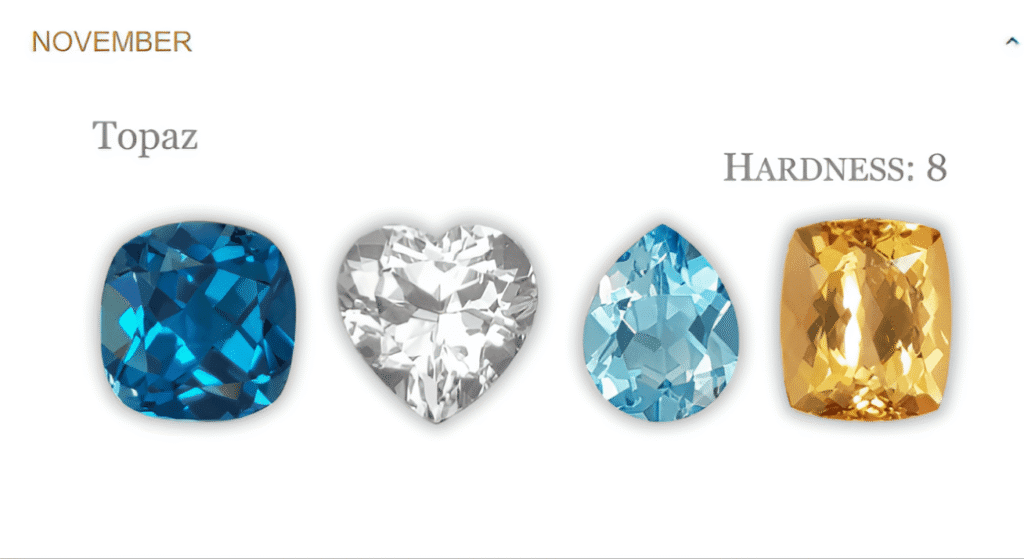
December: Turquoise, Tanzanite, and Zircon. Warriors, shamans, and kings carried Turquoise, one of the oldest known gemstones. Tanzanite, discovered only in 1967 near Mount Kilimanjaro, displays remarkable violet-blue colours. Zircon, the oldest mineral on earth, offers a brilliant sparkle in various colours, though blue is most associated with December.
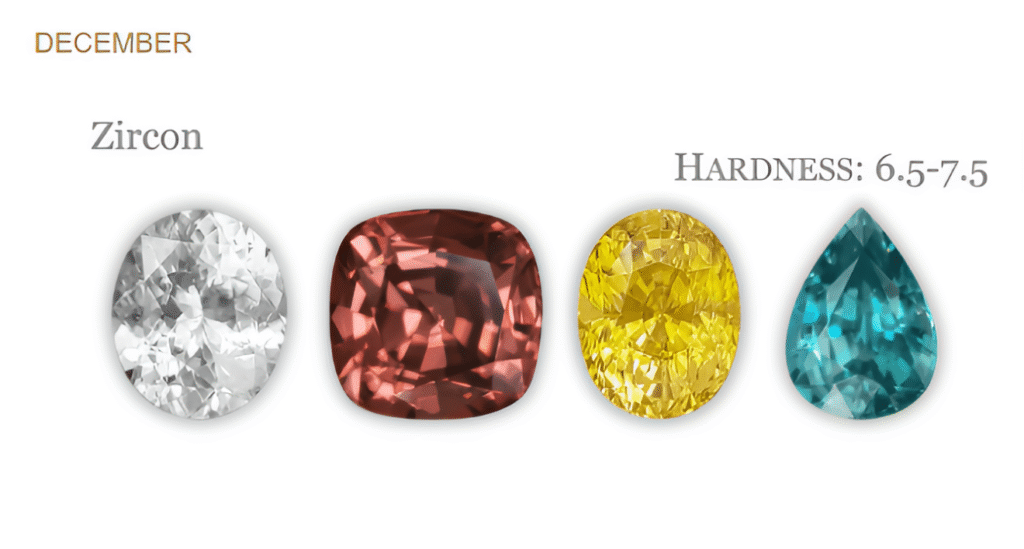
Traditional vs. Modern Birthstone Interpretations
How Birthstone Assignments Have Changed
The birthstones we recognise today reflect centuries of evolution across cultures. Established in 1912, the jewellery industry has revised the modern list several times to accommodate gemstone availability, consumer preferences, and new discoveries.
The most recent change occurred in 2016, when spinel was added as an August birthstone, alongside peridot. Before that, in 2002, tanzanite joined turquoise and zircon as a December birthstone. These additions reflect both changing tastes and marketing considerations within the jewellery industry.
Multiple Stones for Some Months
Several months now feature multiple birthstone options, giving consumers greater flexibility in choosing stones that resonate with their style and budget. June, August, and December have three options, while October and November have two.
These multiple options allow for more personalised expressions of birth month connections. For example, someone born in June might choose lustrous pearls for traditional elegance, rare alexandrite for its colour-changing magic, or moonstone for its ethereal glow—each carrying distinct symbolism within the birthstone tradition.
The Symbolism and Properties of Birthstones
Spiritual Meanings
Throughout history, birthstones have been associated with significant spiritual and metaphysical properties. Many cultures believed these gems provided protection, enhanced certain personal qualities, or attracted particular energies to the wearer.
Amethyst was thought to promote clarity of thought and protection against intoxication. Emerald was believed to reveal truth and protect against evil spells. Sapphire was supposedly considered to protect its wearer from envy and harm while attracting divine favour. These traditional beliefs deeply ingrained birthstones into cultural practices, extending beyond mere adornment.
In modern interpretations, many people still connect with these traditional meanings while developing more personal relationships with their birthstones. Some view their birthstone as a connection to the unique energy or qualities of their birth month.
Reported Healing Properties
While not scientifically substantiated, various healing properties have been attributed to birthstones throughout history. Crystal healing traditions suggest that different gemstones can affect physical, emotional, and spiritual well-being when worn close to the body.
Garnet is said to boost energy levels and regulate blood flow. Aquamarine has been used to calm nerves and support throat health. Emerald is reportedly beneficial for eyesight and fertility. While these claims should be viewed through a historical and cultural lens rather than as medical advice, they illustrate the enduring human tendency to seek meaning and connection through natural elements, such as gemstones.
Choosing the Perfect Birthstone Jewellery
Considerations for Custom Pieces
When designing custom birthstone jewellery, several factors deserve consideration beyond simply selecting your birth month’s stone. At Joseph George Jewellery, we guide clients through each of these considerations:
Stone Durability: Some birthstones (like diamonds, sapphires, and rubies) are exceptionally durable and suitable for daily wear in rings. Others (like opals, pearls, and emeralds) require more protective settings for long-term durability.
Metal Pairing: Different stones pair beautifully with specific metals. For example, the cool tones of aquamarine often look stunning in white gold or platinum, while the warmth of citrine complements yellow or rose gold beautifully.
Setting Style: The correct setting enhances the beauty and security of your birthstone. Emeralds typically benefit from bezel settings that protect their edges, while diamonds can showcase their brilliance in prong settings.
Personal Significance: We often incorporate elements beyond the birthstone itself—perhaps a design motif significant to you, or subtle details that tell your unique story.
Combining Multiple Birthstones
Creating jewellery that combines multiple birthstones opens creative possibilities for commemorating relationships or significant life events:
- Family jewellery featuring the birthstones of children or loved ones
- Anniversary pieces incorporating both partners’ birthstones
- Stackable rings or layered necklaces representing different family members
- Custom designs celebrating milestones with relevant birthstones
When designing such pieces, we consider colour harmony, proportion, and the unique properties of each stone to create balanced, beautiful compositions that honour essential connections.
Caring for Your Birthstone Jewellery
Maintenance Tips by Stone Type
Proper care ensures your birthstone jewellery remains beautiful for generations. Different stones require specific care approaches:
Hard Stones (Diamonds, Sapphires, Rubies):
- Can be cleaned with mild soap and water using a soft brush
- Ultrasonic cleaners are generally safe
- Store separately to prevent scratching other jewellery
Medium Hardness (Aquamarine, Topaz, Amethyst):
- Clean with mild soap and water
- Avoid prolonged sunlight exposure, which can fade some colored stones
- Avoid sudden temperature changes
Soft or Porous Stones (Emerald, Opal, Pearl, Turquoise):
- Clean only with a damp, soft cloth
- Never use ultrasonic cleaners
- Keep away from chemicals, including perfumes and hairsprays
- Some benefit from occasional rehydration (opals) or oiling (emeralds)
Annual professional cleaning and inspection help identify issues before they affect the stone’s security or appearance, especially for frequently worn pieces.
Conclusion
Birthstones connect us to tradition, meaning, and beauty in uniquely personal ways. Whether you’re drawn to your birth month’s gem for its symbolism, aesthetic appeal, or connection to your personal story, birthstone jewellery creates a meaningful bridge between ancient traditions and contemporary expressions of identity.
At Joseph George Jewellery, we honour the rich history and significance of birthstones for each of our clients. Our custom design approach ensures your birthstone piece reflects not just centuries of tradition but also your unique personal story.
Ready to explore the possibilities of custom birthstone jewellery? We invite you to book an appointment to discuss your vision or contact us with any questions about creating your perfect birthstone piece with a Melbourne Jeweller.
Frequently Asked Questions About Birthstones
What if I don’t like my birthstone? There is no rule stating that you must wear your assigned birthstone. Many choose birthstones from significant months (such as anniversaries or children’s birthdays) or select gems whose properties or appearance resonate with them. Alternative options include birth flowers, zodiac stones, or stones associated with your astrological ruling planet.
Can I combine multiple birthstones in one piece of jewellery? Absolutely. Custom-designed pieces with multiple birthstones create meaningful connections to loved ones or significant life events. At Joseph George Jewellery, we specialise in thoughtfully combining stones with different properties and characteristics into harmonious, balanced designs.
What’s the difference between precious and semi-precious birthstones? Traditionally, only diamonds, rubies, sapphires, and emeralds were classified as “precious,” with all other gemstones considered “semi-precious.” This distinction originated more from historical scarcity than inherent value. Today, many “semi-precious” stones, such as fine alexandrite or paraiba tourmaline, can be more valuable than some “precious” stones. Quality, rarity, and beauty determine a stone’s value rather than this traditional classification.
Are birthstones a good investment? While some exceptional quality birthstones (particularly diamonds, rubies, sapphires, and emeralds) can appreciate in value, most birthstone jewellery should be viewed primarily as an emotional investment rather than a financial one. Factors affecting potential value include stone quality, rarity, size, and provenance. However, the personal significance often constitutes the actual value of birthstone jewellery.
How do I know if my birthstone is genuine? Purchasing from a reputable jeweller, such as Joseph George, ensures authenticity. We provide certification for significant stones and emphasise transparency about treatments or enhancements. Different stones have different identifying characteristics—for instance, natural emeralds typically contain inclusions called “jardins,” while synthetic emeralds often appear too perfect.
Can birthstones be worn every day? Some birthstones are ideal for daily wear, while others require more careful treatment. Diamonds (April), sapphires (September), and rubies (July) are highly durable (8-10 on the Mohs scale) and excellent for everyday rings. Opals (October), pearls (June), and emeralds (May) are softer and more vulnerable to environmental factors, making them better suited for occasional wear or protective settings.
What are the rarest and valuable birthstones? Among birthstones, fine quality rubies, sapphires, emeralds, and diamonds command the highest prices, particularly in larger sizes. However, stones like alexandrite (June) and red spinel (August) can be extraordinarily valuable in exceptional qualities. The most valuable birthstone is often considered natural alexandrite with strong colour change properties, which can exceed the value of diamonds of equal weight.

